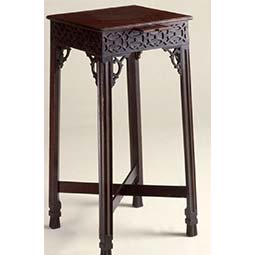Urn Stand

Urn stand
Anthony Hay
Williamsburg, Virginia
1765-1775
Mahogany and tulip poplar
1952.0063
Crafted by the Anthony Hay shop in Williamsburg, Virginia, this fashionable mahogany urn stand features applied fretwork similar to examples found within Thomas Chippendale’s Gentleman and Cabinetmaker’s Director. An expensive commodity throughout the Western world, the mahogany used in the stand was sourced in the Caribbean islands using the labor of enslaved Africans. Established during the late 1750’s, the Anthony Hay shop catered to those who could afford such luxury materials – a socially elite demographic that often gained their wealth through enslaved labor.
As the original master of the shop, Anthony Hay (1700-1770) oversaw the work of multiple journeymen, apprentices, and itinerant carvers– including an enslaved man named Wiltshire, described as “a very good Cabinet Maker” in Hay’s probate inventory. While records of Wiltshire picking up supplies for the Hay shop from Williamsburg’s printing office in 1764 survive, most details of his life remain unknown.
Wiltshire’s experience as an enslaved tradesperson was not uncommon. From Newport, Rhode Island, to Charleston, South Carolina, skilled enslaved artisans worked in cabinetmaking shops throughout the Colonies. Enslaved men and women who learned skilled trades at first followed a path similar to apprentices, yet unlike apprentices, they often never earned their freedom.
